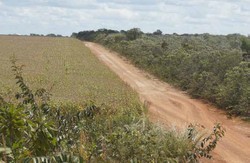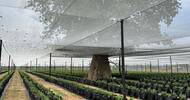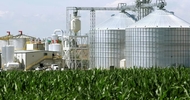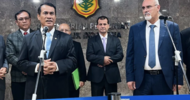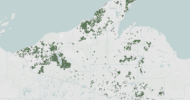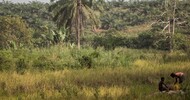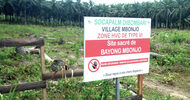FOE | 30 April 2018
Is land speculation helping destroy Brazil’s “birthplace of waters”?
Is land speculation helping destroy Brazil’s “birthplace of waters”?
by Jeff Conant, senior international forests program manager
An interview with Fabio Pitta of the Brazilian Network for Social Justice and Human Rights
If you’re like most U.S. Americans, when you think about Brazil, you might picture the beaches of Rio de Janeiro or the mighty Amazon River or World Cup soccer. If you pay attention to environmental issues, then you’ll be aware of Brazil as a country facing massive deforestation for cattle, soy, and other industrial crops. And if you give any attention to Latin American politics, you know that Brazil suffered a right-wing coup in 2016 with repercussions that deepened violence, corruption, and instability. But you may not be aware of the deepening destruction of what has been called “a magnificent global treasure,” “a mighty ecological treasure trove,” and, next to the Amazon, “Brazil’s other wonderland”: a vast mosaic of wetlands, grasslands, scrublands, and seasonally dry forests in the heart of Brazil, known as the Cerrado.
Known in Brazil as the “birthplace of waters,” because eight of Brazil’s 12 major river basins draw their water from the region, the destruction of the Cerrado is increasingly seen as Brazil’s largest ecological disaster-in-progress. The Cerrado’s native vegetation once covered nearly 800,000 square miles — an area bigger than Great Britain, France, and Germany combined. Today, less than half of it remains.
Last month an article in one of Brazil’s largest papers opened with suitable drama: “The Cerrado is the richest savanna in the world, and it’s being destroyed.” Another recent article calls the Cerrado “the birthplace of modern ecology”, because it is where scientists first understood how local ecology shapes the evolution of species. But today, in the words of that article, “The fruits of converting the Cerrado are fed into the maw of the global commodity market — soybeans to feed livestock in China, sugar cane to make ethanol to meet U.S. biofuel mandates, beef to feed the world’s growing middle classes… In a bet that these global appetites will keep expanding, the retirement investment giant TIAA-CREF has spent hundreds of millions to purchase Cerrado farmland in the frontier states of Maranhão and Piauí.”
Just as the unique ecology of the Cerrado is undergirded by the deep roots of its low scrub vegetation, the destruction of the Cerrado appears to be undergirded by a largely invisible set of forces — the large scale acquisition of land by land speculators and foreign investors, including some that for many Americans, are very close to home. A recent article in Bloomberg details land investments by Harvard University, and another in Mongabay highlights continued land speculation by TIAA and other global investors.
On the occasion of a new report on land speculation in the Cerrado by the Brazilian Network for Social Justice and Human Rights, Friends of the Earth (FOE) has interviewed one of the report’s authors, Fabio Pitta, in order to shine some light on the issue.
FOE: Your report describes land speculation driving the destruction of the Cerrado. What’s the root of this problem?
Fabio: The Cerrado in the Northeast of Brazil is constituted by high, flat plateaus where soybean production has expanded tremendously in the last 15 years. This expansion grew rapidly during the so-called commodities prices bubble (2003–2012). Because of that, land prices also increased exponentially, and land in the Cerrado became very appealing to investors. After the burst of commodity bubbles, some agribusiness corporations with huge financial backing started to create partnerships to keep investing in land as a financial asset. This essentially meant that land was now functioning as a stock option. The main deal with land in the Cerrado became a race to buy low and sell high.
Most communities have lived in this area for about 150 years, but most have no land titles. This creates rich terrain for speculation and land theft: land grabbers falsify documents, evict communities, sometimes deforest the plateaus, and then sell the land as if it were legal.
FoE: One of the subjects of your study is a company called Radar that was formed by U.S. investment firms TIAA and Cosan, Brazil’s largest sugar producer, specifically to buy land in the Cerrado. In 2016, Cosan sold its stake in Radar to Mansilla, another TIAA subsidiary. So you have what appears to be one TIAA subsidiary selling land to another TIAA subsidiary, and partnering with agribusiness firms to do it. Why do you think they did this, and what effect did this have?
Fabio: When Cosan sold most of its stake (they kept three percent, and TIAA appear as investors), for us this was proof that they were treating land as a financial asset. They bought cheap land in the Cerrado, waited for the price to get higher, and then they sold it to TIAA at a profit. This was the apex of the process we’re talking about, which you could call “land speculation.”
FoE: TIAA developed a set of guidelines for responsible investment in land, presumably to avoid causing land conflicts. In your view, are these guidelines weak, or is TIAA ignoring them?
Fabio: The main point here has to do with land as a financial asset, where what they call responsible investment is not enough to address the deeper issues here. When land is grabbed through falsified land titles, the intention is to make it very difficult to prove the illegality. So, even with responsible investment, if you take a quick look at the title itself, it will appear legal. Radar does not grab land directly by itself, they outsource land grabbing, often buying land from others who illegally grabbed it. Even if they pledge they did not know, it is a cynical argument, because we’ve been telling them about it for three years. If you do a simple search on the internet on the entrepreneur who was selling land to Radar in the Maranhão and Piauí Cerrado areas, you will see this sort of investment is not trustworthy at all.
In another sense, if you invest in land markets, without even producing on that land, you increase land prices and you are responsible for driving the social and environmental impacts of land concentration.
FoE: TIAA is only one among many large landowners in the region. They have told us that their farms are all subject to sustainability certifications, that they are following “sustainable” practices. Why pick on them?
Fabio: Radar has the same characteristics that any other rural real estate corporation has. They have almost $1 trillion dollars in investment capital. The amount of money invested in an asset can drive its prices up or down, can drive market speculation. Radar is a partnership between Cosan, a sugar cane agroindustry, and TIAA. Radar was buying land in a soybean expansion area. They were not interested in the area for sugar production. Other rural real estate corporations invest also in land as a financial asset but most of them are related to soybean expansion on the area.
So Radar owns huge territories that they have not deforested, but that they hold onto for speculation. For TIAA to be involved in this creates a trend among other investors and pension funds. We assume that if they divest from this sort of business, others would do that also.
FoE: The properties owned by TIAA’s subsidiaries in the Cerrado — do you have clear evidence that they are being deforested?
Yes we do. TIAA uses cynical arguments to deny they are responsible for the grave impacts on the Cerrado. Cerrado deforestation, different from the Amazon Forest in Brazil, is allowed in lots of cases by the state governments. It does not mean this deforestation does not have huge and deep impacts for communities and environment. They know that, but they try to say that they do not deforest because a part of their deforestation may be legal. Even so, the Cerrado is being devastated.
FoE: What other environmental problems have you seen on TIAA’s properties and others in the Cerrado?
Fabio: They are huge and the environmental impacts bring deep social impacts. Rivers used by communities dry up or are polluted by pesticides that cause serious health impacts. With the deforestation of the plateaus, communities can’t access these areas to herd cattle, to collect fruits, to hunt, to collect medicines. So they are not able to survive on the land. And the impacts are broader than just this area. The Cerrado is responsible for lots of water springs and rivers. The whole Brazilian countryside and the whole continent are being affected by a huge drought these last years. See for example the São Paulo water crisis of 2014–2016. That is caused by the deforestation of the Cerrado.
The use of airplanes to release pesticides in the soy plantations are terrible for the communities’ own farms. They used to grow yuca, corn, rice, beans, and vegetables. The pesticides destroy their production, so they are not safe, even in the low lands, where the rivers flow (the springs are on the plateaus and are being destroyed also by deforestation and soybean production), the only areas left for them to live on.
FoE: Don’t these large farms provide jobs for local people, and improve the economy?
Fabio: Soybean farming is extremely mechanized. Employment is extremely low. Enterprises bring with them their own tractor pilots from the Center-South of Brazil. People evicted from the communities are hired in overexploited conditions to dig out stones and roots from the soybean farms for sthree months, and after that they’re fired. After losing the plateaus, people need to sell their labor so they tend to accept any work they can find. They find the worst labor conditions ever and they must accept them.
FoE: Is there anything else you want to tell people in the United States, and particularly those whose retirement funds are managed by TIAA, about what’s happening in the Cerrado?
Fabio: It is very difficult to find out the relation between international financial investments and land grabbing processes in rural regions in Brazil. They are not crystal clear, they are not explicit. Financial investments tend to hide their sources. When we first visited the region nobody knew about it. Locally, it is also difficult to find juridical proofs about illegal land grabbing. The titles are falsified and often the notary offices are involved with the falsification. It is difficult to have access to official documents and it is also very dangerous as local land grabbers use violence and physical threats (including murder).
The first step to understand these illegal processes is to visit the region, and access is very difficult. When you start to research and you listen to the communities’ history, you start to realize something very, very wrong is going on. Communities are very poor, it is a capitalist social tragedy. And it is not just in the Cerrado — this is a global process of turning land into a financial asset in Africa, Australia, and even inside the USA.
To learn more, read the report, Transnational Corporations and Land Speculation in Brazil.


